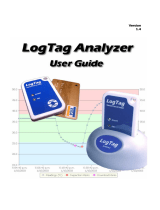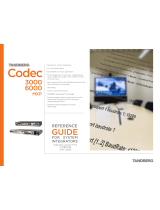Page is loading ...

1. SETUP AND CONFIGURATION
Download and install LogTag Analyzer from our website:
www.logtagrecorders.com/software
Connect the Interface Cradle to your computer and insert the Logger into the Interface Cradle with the
label to the front. You will hear a click as the contacts engage.
Start LogTag Analyzer. In order to start using your Logger, you need to configure it via the ‘LogTag Wizard’.
This can be accessed by pressing ‘F2’ on your keyboard or by clicking the ‘Wizard’ icon.
1
2
34
5
6
7
8
1. Description: Enter details to identify your Logger. E.g. refrigerator 3. Also the status of your battery is
indicated here.
2. Password: You have the option to specify a password, which needs to be entered the next time
someone configures the Logger or when the results will be downloaded.
3. Push button start or date/time start: You can start your Logger by pushing the start button or
automate the start by selecting a date/time when the Logger should start recording.
4. Enable pre-start logging: When you select this option the Logger will start recording immediately after
configuration. This is useful in case the user forgets to start the Logger.
5. Record readings so that...: Specify how long you wish to record for.

2. STARTING THE LOGGER
If the Logger has been configured with a Date/Time start, it will start automatically at the configured time.
For push-button start, when the display shows ‘READY’, press and hold the ‘START/CLEAR/STOP’
button. Continue to hold while ‘STARTING’ flashes on the display and release the button when the flashing
stops.
The Logger will now display the delayed start time remaining (if configured). Once recording, the word
‘RECORDING’ will be shown on the display.
During recording, the display shows the temperature of the last reading taken, the current time, battery
status and a combination of alarm status and history.
A reading is taken and the display updated every logging interval as configured in LogTag Analyzer. When
you press the button, the next reading taken by the logger will be identified in the downloaded data with
an inspection mark.
3. DOWNLOAD / RESULTS
1. Open LogTag Analyzer.
2. Insert the Logger into the Interface Cradle.
3. After a few seconds, the downloaded data will appear. Data can be displayed in
Chart-, Data-, Summary- or Day Summary formats by clicking the tabs at the bottom of the
chart dialog. Data can also be saved in a number of formats including TXT, PDF, HTML and
CSV for import.
6. Record a reading every...: Choose the duration between each reading.
7. Begin recording after a delay of: Enter a start delay if required. A start delay commences upon
pressing the start button. This allows the Logger to reach the right temperature before recording starts.
This option wont be available with a date/time start.
8. Setting upper / lower alarm: Specify the upper temperature alarm and/or the lower temperature
alarm if you would like to trigger an alarm.
Optional; enable the audible alarm to alert nearby staff when an alarm has been triggered and an option
to set the temperature unit.
Note: Have you forgotten to press the start button? A pre-start recording feature can be
activated, to make sure the Logger will monitor the temperature even before the trip has
started. No alarms are processed during pre-start logging.

4. ADDITIONAL INFORMATION
Reviewing day statistics
The Logger will display up to 30 days of max/min/duration and alarm statistics. If the Logger is configured
to record longer than 30 days (or continuously) then the day statistics will contain up to the latest 30 days.
To review the day statistics, press the ‘REVIEW/MARK’ button. Each press of the button will step through
the Max and Min temperatures for each day starting with today and moving backwards
through the days (displayed day will flash). Any button activity during recording will
place an inspection mark in the next reading of logged data which will be displayed
when the data is downloaded.
Following are some examples:
Pressing the ‘REVIEW/MARK’ button displays current days ‘MAX’ statistic. The
‘TODAY’ segment flashes and ‘DAY 0 0’ is shown to indicate the ‘TODAY’ selection.
The selected day (today) does not have any recordings outside the pre-set limits.
Pressing the ‘REVIEW/MARK’ button again displays the days ‘MIN’ statistic. The ‘MIN’
statistic is not below the limit and did not trigger an alarm.
Pressing the ‘REVIEW/MARK’ button again displays the next previous days ‘MAX’
statistic. The ‘MAX’ in this example is above the upper limit and the ‘ALARM’ was
triggered for a duration of 10 hours and 11 minutes.
Pressing the ‘review button’ again displays the
days ‘MIN’ statistic. The ‘MIN’ statistic is not below the limit and did not trigger an alarm.
If less than 30 days of recordings have been collected, the day marker only advances as far as there is
data available. After the last day for which statistics have been collected is displayed, the next press of
the ‘START/CLEAR/STOP’ button rolls the summary back to the statistic for ‘TODAY’.
Display overview

Recording display
During recording, the display shows the temperature of the last reading taken, the current time, battery
status, a combination of alarm status and history. A reading is taken and the display updated every
logging interval, as configured in LogTag Analyzer.
Following are some examples:
In this example the display shows that alarm events occurred 7, 19, 20 and 25 days
ago. These alarms were cleared by an inspector as the display currently shows no
“ALARM” symbol. The current temperature is over the upper limit (indicated by the
arrow pointing up) but has not been over for long enough to trigger an alarm.
20 minutes later the over temperature has triggered an alarm. The ‘ALARM’ symbol and
the ‘TODAY’ marker day alarm are shown.
The next day, the temperature has returned to the acceptable range but the alarm
remains present. The day summary has shifted by 1 day as the time has gone through
midnight.
Clearing an alarm
When an alarm event has occurred, the ‘X’ symbol is displayed. To clear the ‘X’ symbol from the display,
press and hold the ‘START/STOP/CLEAR’ button until the ‘X’ symbol stops flashing, then immediately
release. Alarm events continue to be displayed in the history area of the display and can be reviewed with
the day statistics.
The option to clear and latch alarms can be disabled, see advanced options in LogTag Analyzer.
Stopping the Logger
If enabled, you can stop the Logger; press and hold the ‘START/CLEAR/STOP’ button. Continue to hold
while ‘STOPPED’ flashes on the display; release the button when the flashing stops. The Logger will no
longer take any readings, however you can still review the day statistics and download the logged results
to a PC with LogTag Analyzer.
The option to stop the Logger can be disabled during configuration, see advanced options in LogTag
Analyzer.
Re-activating the Logger
If enabled, the Logger can be re-activated for re-use by either re-configuring using LogTag Analyzer or
by using the following procedure; press the ‘START/CLEAR/STOP’ button. The ‘READY’ text will start
flashing on the display. Release the button when the flashing stops.
The Logger will then be ready for a push button start. Date/time start is only possible by re-configuring
with LogTag Analyzer. Be aware that re-activating the Logger will erase all previously recorded readings
and statistics! The option to re-activate the Logger can be disabled during configuration, see advanced
options in LogTag Analyzer.
Setting the display clock
LogTag Analyzer sets the Loggers internal real time clock to the configuration PC’s time, however the user
can manually change the display clock if required. Press and hold the ‘START/CLEAR/STOP’ button
and ‘REVIEW/MARK’ button together continuously for 8 seconds. During this period the display will flash
‘CLOCK ADJ’.
Release the buttons when the flashing stops to enter ‘CLOCK ADJ’ mode. The minutes will flash. Press
the ‘START/CLEAR/STOP’ button to put in the minutes and press the ‘REVIEW/MARK’ button to accept
the minute changes and to start editing the hours.
The hours will now flash.
Press the ‘REVIEW/MARK’ button to increment the hours and press the ‘START/CLEAR/STOP’ button to
accept and store the new time. If recording is active a clock change event will be recorded with the next
logged reading, which will be displayed in the downloaded data.

BATTERY REPLACEMENT
The TRID30-7F has a fixed battery and can’t be replaced. Please note that your Logger does contain a
non-rechargeable Lithium Battery, which must be disposed of in accordance with local regulations.
The TRID30-7R battery can be replaced. The Loggers use a commonly available battery (CR2032); to
safeguard your data we recommend you use a reputable, branded battery.
Check the label on the back to find your model number.
The battery status can be found in the configuration screen. If you would like to know more about the
battery life of your Logger or how to replace your battery, please visit our website / knowledge base.
HIBERNATION
To prolong the life of your Logger you can hibernate your Logger between trips when it is not being used
for extended periods. Loggers can be hibernated via LogTag Analyzer by selecting ‘Hibernate’ from the
LogTag menu. When hibernated, all logging functions are suspended, all indicators are turned off and
internal components are switched to low power. This reduces the current consumption on Loggers to very
low levels.
Check our website for more information about the hibernation setting.
CALIBRATION
In order to calibrate your Logger, you need to use our LogTag Calibrate software. LogTag Recorders
releases our LogTag Calibrate software only to selected users who have suitable equipment and
credentials relating to standard practices of temperature and/or humidity calibration.
If you require calibration of your Logger(s), please contact your local supplier.
WATER DAMAGE
Please remember that none of the Loggers can be immersed into liquids. For more specific information,
check your user guide for the IP rating.
CONTACT CLEANING
Keep the three metal contacts at the back of the Loggers clean and free from tape residue, dirt or other
contaminants, which could result in communications problems. If required, clean them with a soft pencil
eraser, but don’t use abrasive materials as you may permanently damage them.
/







